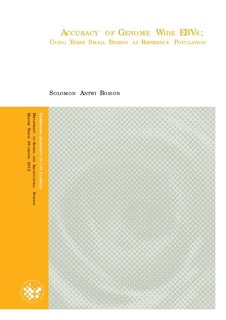Accuracy of Genome Wide EBVs : using three small breeds as reference population
Master thesis
Permanent lenke
http://hdl.handle.net/11250/186032Utgivelsesdato
2012-08-21Metadata
Vis full innførselSamlinger
- Master's theses (IHA) [318]
Sammendrag
Accuracy of genomic breeding values (GEBVs) is largely determined by the number of animals used in training and predicting marker effect. Thus in populations with limited number of animals, there are the need to combine populations or breeds to increase the reference population. The objective of this study was to investigate the accuracy of genomic selection using a single breed and multibreed reference population of the Austrian breeds Braunvieh, Grauvieh and Pinzgauer. Genomic relationship matrix (GBLUP) and Bayesian methods (Bayes-B and wgt.GBLUP) that increase the weight of certain important SNPs were used to predict marker effect. Accuracies were estimated using the 60 youngest bulls and calculated as the correlation between GEBV and published estimated breeding values (EBVs) for single breed and multibreed. Deregressed EBVs were used as phenotypes and a total of 10 traits were analysed. Accuracy of GEBV averaged across the 3 methods and the 10 traits for single breed ranged from 0.46 to 0.52. Two-way combined breed analysis gave an average accuracy of 0.46 and a three-way combined breed analysis was 0.45. Accuracies were not significantly different between methods; GBLUP, Bayes-B and wgt.GBLUP. Multibreed training set yielded maximum gain of about 17% in a both two and three -way analysis. However, on average combining 2 breeds increased accuracy by only 1.9% and a loss of 1.32% for a combination of 3 breeds. Combining breeds to increase the number of animals used in predicting marker effect and estimates GEBV for young bulls increased accuracy but this was not consistent across traits.
Beskrivelse
European Masters in Animal Breeding and Genetics
